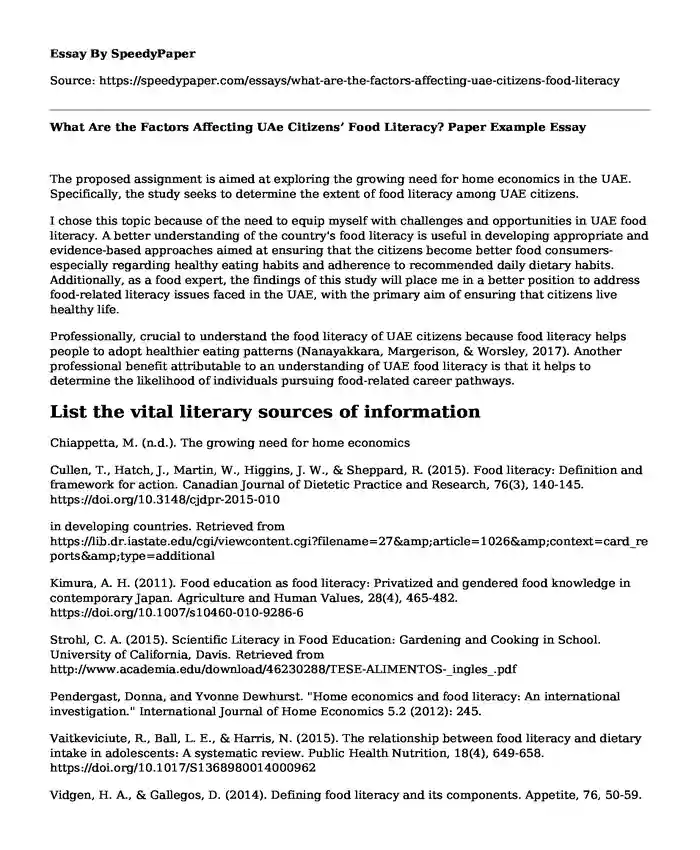
| Type of paper: | Research proposal |
| Categories: | Food World Case study Community |
| Pages: | 3 |
| Wordcount: | 785 words |
The proposed assignment is aimed at exploring the growing need for home economics in the UAE. Specifically, the study seeks to determine the extent of food literacy among UAE citizens.
I chose this topic because of the need to equip myself with challenges and opportunities in UAE food literacy. A better understanding of the country's food literacy is useful in developing appropriate and evidence-based approaches aimed at ensuring that the citizens become better food consumers- especially regarding healthy eating habits and adherence to recommended daily dietary habits. Additionally, as a food expert, the findings of this study will place me in a better position to address food-related literacy issues faced in the UAE, with the primary aim of ensuring that citizens live healthy life.
Professionally, crucial to understand the food literacy of UAE citizens because food literacy helps people to adopt healthier eating patterns (Nanayakkara, Margerison, & Worsley, 2017). Another professional benefit attributable to an understanding of UAE food literacy is that it helps to determine the likelihood of individuals pursuing food-related career pathways.
List the vital literary sources of information
Chiappetta, M. (n.d.). The growing need for home economics
Cullen, T., Hatch, J., Martin, W., Higgins, J. W., & Sheppard, R. (2015). Food literacy: Definition and framework for action. Canadian Journal of Dietetic Practice and Research, 76(3), 140-145. https://doi.org/10.3148/cjdpr-2015-010
in developing countries. Retrieved from https://lib.dr.iastate.edu/cgi/viewcontent.cgi?filename=27&article=1026&context=card_reports&type=additional
Kimura, A. H. (2011). Food education as food literacy: Privatized and gendered food knowledge in contemporary Japan. Agriculture and Human Values, 28(4), 465-482. https://doi.org/10.1007/s10460-010-9286-6
Strohl, C. A. (2015). Scientific Literacy in Food Education: Gardening and Cooking in School. University of California, Davis. Retrieved from http://www.academia.edu/download/46230288/TESE-ALIMENTOS-_ingles_.pdf
Pendergast, Donna, and Yvonne Dewhurst. "Home economics and food literacy: An international investigation." International Journal of Home Economics 5.2 (2012): 245.
Vaitkeviciute, R., Ball, L. E., & Harris, N. (2015). The relationship between food literacy and dietary intake in adolescents: A systematic review. Public Health Nutrition, 18(4), 649-658. https://doi.org/10.1017/S1368980014000962
Vidgen, H. A., & Gallegos, D. (2014). Defining food literacy and its components. Appetite, 76, 50-59. https://doi.org/10.1016/j.appet.2014.01.010
Give examples of similar research cited in literature that has been carried out in this area. Food literacy refers to daily practicalities linked to healthy eating (Vidgen & Gallegos, 2014). It is comprised of four domains of food practices: eating, preparation, selection, and planning and management of food (Vidgen & Gallegos, 2014). Food literacy has also been described as the presence of a positive association built through environmental, cultural, and social experiences with food that enables individuals to make decisions aimed at supporting health (Cullen et al., 2015). It can only be achieved if citizens have food-related skills and behaviors linked to their social and environmental contexts. One of the ways in which food literacy can be achieved is through food education (Kimura, 2011). Food literacy is important in making health-related decisions such as dietary intake among adolescents (Vaitkeviciute, Ball, & Harris, 2015). Teenagers who are frequently involved in the preparation of food have dietary health consumption (Vaitkeviciute et al., 2015).
Pendergast, Donna, and Yvonne Dewhurst (2012) conducted a study aimed at investigating the relationship between home economics and food literacy. The findings of this study revealed that food literacy skills should be incorporated in early childhood education in collaboration with educational stakeholders such as the community, parents, and teachers. However, Pendergast et al. (2012) did not establish whether inadequate literacy skills affect healthy eating habits. In a related study, Chiappetta (n.d.) found out that there is a need to expand home economics education, with more focus on the boys because of their inadequate skills.
Strohl (1998) further also established that the need to ensure that all citizens achieve scientific literacy is attributable to nutritional, environmental, and agricultural issues that the world faces today. Strohl (1998) also reported that reliance on traditional science teaching methods leads to failure to address diverse aspects of scientific literacy. One of the effective approaches that is crucial in fostering scientific literacy is school gardens. Additionally, culinary arts instruction was found to be an effective approach to teaching food literacy. This instructional technique and its connection to core academic subjects, teachers are capable of nurturing food literacy because it provides students with opportunities for food-related practical activities at the personal, interpersonal, and community level.
Cite this page
What Are the Factors Affecting UAe Citizens' Food Literacy? Paper Example. (2023, Mar 24). Retrieved from https://speedypaper.net/essays/what-are-the-factors-affecting-uae-citizens-food-literacy
Request Removal
If you are the original author of this essay and no longer wish to have it published on the SpeedyPaper website, please click below to request its removal:
- Free Essay on Healthcare Reform: Management Action Plan
- My Musical Heritage - Free Essay on the Dominican Music
- Free Essay: The Prospective Morning Meditation
- Causes of Prison Gang Essay Sample
- Essay Sample on Personal Statement for Ph.D. in Chemistry
- Free Essay Example: Creating a Strategic Plan
- Essay Sample on Psychoanalytical Criticism of Sonny's Blues by James Baldwin
Popular categories




